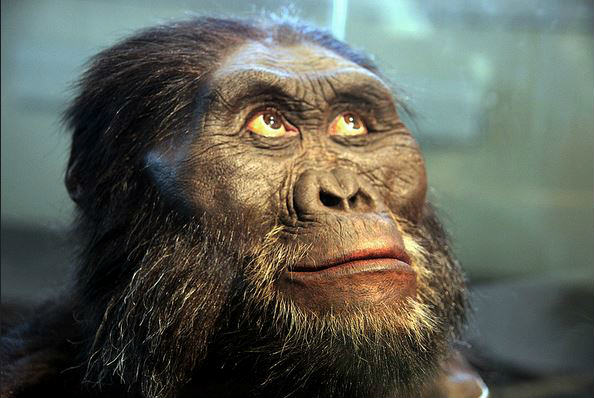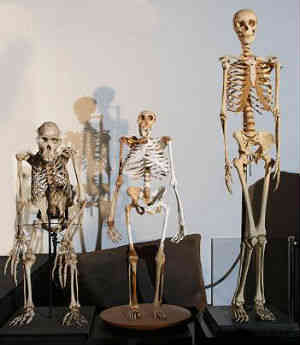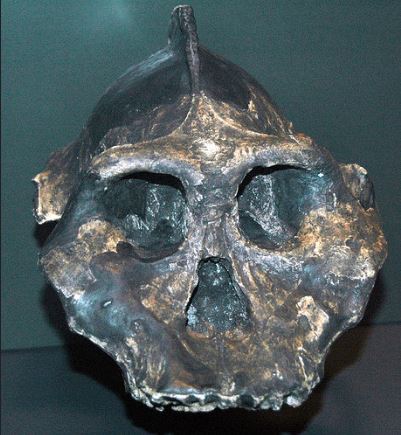Australopithecines
Early human ancestors
Online Biology Dictionary
 One of the best-known australopithecines, Australopithecus afarensis, on display in the Hall of Human Origins in the Smithsonian Museum of Natural History in Washington, D.C. - 2012-05-17 (Image: Tim Evanson).
One of the best-known australopithecines, Australopithecus afarensis, on display in the Hall of Human Origins in the Smithsonian Museum of Natural History in Washington, D.C. - 2012-05-17 (Image: Tim Evanson). Australopithecine (center), ape (left), and modern human (right) compared side by side. Image: Wits University.
Australopithecine (center), ape (left), and modern human (right) compared side by side. Image: Wits University.Image: Nat. Museum of Kenya.
Australopithecines were early hominids.
Two general types are recognized, those with lighter (gracile) bone structure, assigned to the genus Australopithecus, and those with a sturdier (robust) build, assigned to the genus Paranthropus (the members of Paranthropus are sometimes treated as also belonging Australopithecus). Known fossils attributed to these forms range from about 1.2 to 4.2 million years in age. Most experts say the members of Ardipithecus and Kenyanthropus are also australopithecines. If this latter view is correct, then the earliest known fossils belonging to creatures of this type would date to 5.8 mya (Ardipithecus kadabba).
Although australopithecine — a name coined by Raymond Dart who discovered the first specimen (the Taung Child) — means southern ape, these creatures were not simply apes because they were bipedal. Their arms were also shorter in proportion to their height than are those of an ape (but not so short as are a human's)
The robust forms had larger teeth and a stouter skull structure than gracile types. In general, the features that distinguish the robust skull are associated with a strong chewing apparatus — larger teeth, a heavier jaw, and a sagittal crest allowing a large attachment surface for the jaw muscles. With respect to these features, the robust forms tended toward the morphology of modern gorillas.
There is some doubt as to whether these creatures are actually ancestral to modern humans since Homo habilis and Homo erectus, which are both generally accepted as human ancestors, coexisted with them for more than a million years (see human evolution timeline). That is, instead of being our ancestors, australopithecines might have merely been close relatives of the forms that gave rise to modern humans.
An additional fly in the ointment has been the recent discovery of Australopithecus sediba, which existed much more recently than any other member of the genus Australopithecus previously known. Perhaps these creatures were merely a sideline that existed for millions of years and then went extinct.
Pronunciation: "AW-strə-lō-PITH-ə-seenz"
 Paranthropus aethiopicus fossil hominid (Nachukui Formation, Upper Pliocene, 2.5 Ma; Lomekwi, western Lake Turkana area, northern Kenya, eastern Africa). Cranium. Note gorilla-like sagittal crest. Image: James St. John.
Paranthropus aethiopicus fossil hominid (Nachukui Formation, Upper Pliocene, 2.5 Ma; Lomekwi, western Lake Turkana area, northern Kenya, eastern Africa). Cranium. Note gorilla-like sagittal crest. Image: James St. John.
Australopithecus bahrelghazali >>